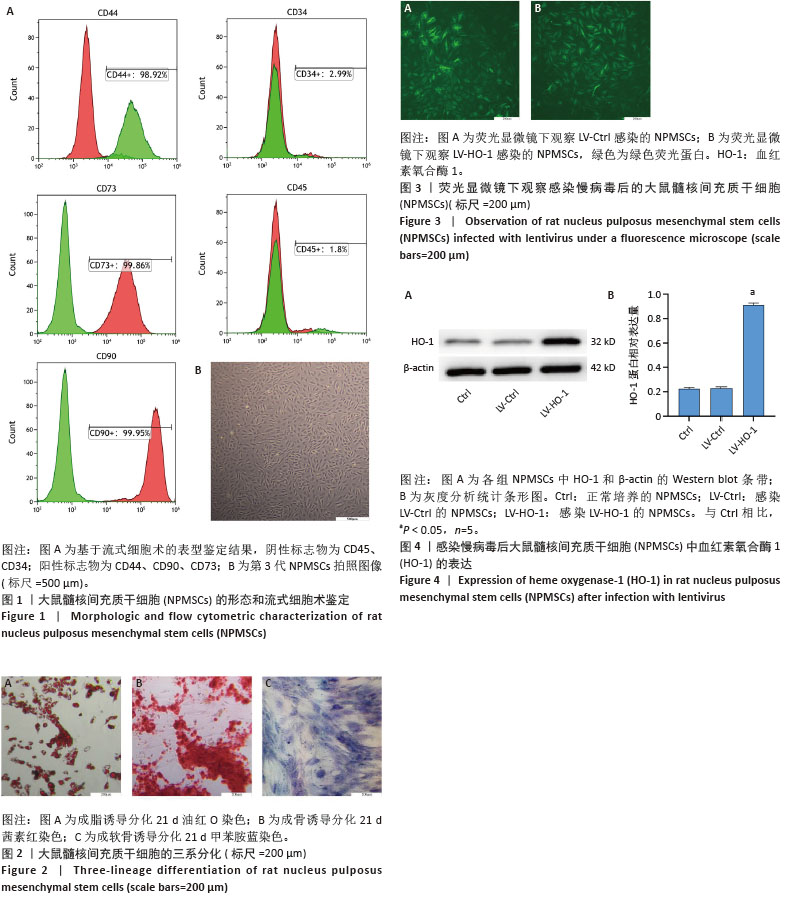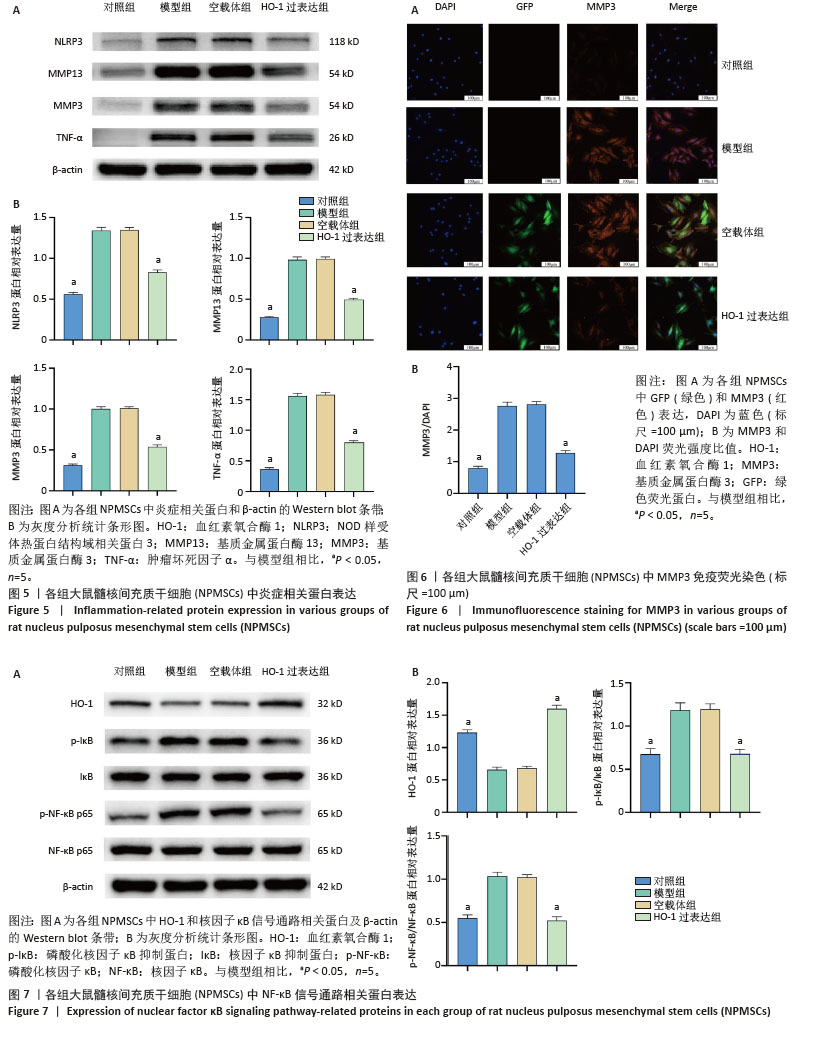[1]LI Q, GUO R, WU Z, et al. Endplate chondrocyte-derived exosomal miR-128-3p mitigates intervertebral disc degeneration by targeting TRAF6 via the miR-128-3p/TRAF6 axis to suppress pyroptosis. Int Immunopharmacol. 2024;143(Pt 3):113620.
[2] ZHAO X, WANG Q, WANG S, et al. A novel multi-omics approach for identifying key genes in intervertebral disc degeneration. SLAS Technol. 2024;29(6):100223.
[3] QIU C, CHENG L, DI D, et al. TNFα-reliant FSP1 up-regulation promotes intervertebral disc degeneration via caspase 3-dependent apoptosis. Genes Dis. 2025;12(1):101251.
[4] HAN J, ZHANG J, ZHANG X, et al. Emerging role and function of Hippo-YAP/TAZ signaling pathway in musculoskeletal disorders. Stem Cell Res Ther. 2024;15(1):386.
[5] XUE P, LV L, LIU L, et al. Unveiling the role of CXCL8/CXCR2 in intervertebral disc degeneration: A path to promising therapeutic strategies. J Orthop Translat. 2024;49:119-134.
[6] MA S, XUE R, ZHU H, et al. Selenomethionine preconditioned mesenchymal stem cells derived extracellular vesicles exert enhanced therapeutic efficacy in intervertebral disc degeneration. Int Immunopharmacol. 2024;132:112028.
[7] SAMANTA A, LUFKIN T, KRAUS P. Intervertebral disc degeneration-Current therapeutic options and challenges. Front Public Health. 2023; 11:1156749.
[8] JIANG Z, CAO C, ZHANG Y, et al. Cell Reprogramming Strategies for Treating Osteoarthritis and Intervertebral Disc Degeneration. Aging Dis. 2024;16(1):5-12.
[9] PENG Y, CHEN X, ZHANG Q, et al. Enzymatically Bioactive Nucleus Pulposus Matrix Hydrogel Microspheres for Exogenous Stem Cells Therapy and Endogenous Repair Strategy to Achieve Disc Regeneration. Adv Sci (Weinh). 2024;11(10):e2304761.
[10] CUI P, SHENG Y, WU C, et al. Puerarin modulates proliferation, inflammation and ECM metabolism in human nucleus pulposus mesenchymal stem cells via the lncRNA LINC01535. Heliyon. 2024; 10(12):e33083.
[11] REN J, XIN R, CUI X, et al. Quercetin relieves compression-induced cell death and lumbar disc degeneration by stabilizing HIF1A protein. Heliyon. 2024;10(17):e37349.
[12] LV W, HU S, YANG F, et al. Heme oxygenase-1: potential therapeutic targets for periodontitis. PeerJ. 2024;12:e18237.
[13] LEE I, YANG C, YANG C. Harnessing peroxisome proliferator-activated receptor γ agonists to induce Heme Oxygenase-1: a promising approach for pulmonary inflammatory disorders. Cell Commun Signal. 2024;22(1):125.
[14] RYTER SW. Heme Oxygenase-1: An Anti-Inflammatory Effector in Cardiovascular, Lung, and Related Metabolic Disorders. Antioxidants (Basel). 2022;11(3):555.
[15] ZHANG J, NI P, SONG Y, et al. Effective protective mechanisms of HO-1 in diabetic complications: a narrative review. Cell Death Discov. 2024;10(1):433.
[16] XIANG Q, ZHAO Y, LIN J, et al. The Nrf2 antioxidant defense system in intervertebral disc degeneration: Molecular insights. Exp Mol Med. 2022;54(8):1067-1075.
[17] XU G, LU X, LIU S, et al. MSC-Derived Exosomes Ameliorate Intervertebral Disc Degeneration By Regulating the Keap1/Nrf2 Axis. Stem Cell Rev Rep. 2023;19(7):2465-2480.
[18] ZHANG Y, YANG S, QIU Z, et al. Pyrogallol enhances therapeutic effect of human umbilical cord mesenchymal stem cells against LPS-mediated inflammation and lung injury via activation of Nrf2/HO-1 signaling. Free Radic Biol Med. 2022;191:66-81.
[19] LU S, LI M, CHENG Z, et al. HMGB1-mediated macrophage regulation of NF-κB activation and MMP3 upregulation in nucleus pulposus cells: A critical mechanism in the vicious cycle of intervertebral disc degeneration. Cell Signal. 2025;127:111628.
[20] SHI M, ZHAO Y, SUN Y, et al. Therapeutic effect of co-culture of rat bone marrow mesenchymal stem cells and degenerated nucleus pulposus cells on intervertebral disc degeneration. Spine J. 2021;21(9):1567-1579.
[21] PIZZICANNELLA J, FONTICOLI L, GUARNIERI S, et al. Antioxidant Ascorbic Acid Modulates NLRP3 Inflammasome in LPS-G Treated Oral Stem Cells through NFκB/Caspase-1/IL-1β Pathway. Antioxidants (Basel). 2021;10(5):797.
[22] 于庆贺,蔡子鸣,田禾,等.芒柄花素抑制脂多糖诱导髓核间充质干细胞的炎症反应[J].中国组织工程研究,2025,29(25):5328-5334.
[23] HUA W, XIE L, DONG C, et al. Procyanidin C1 ameliorates acidic pH stress induced nucleus pulposus degeneration through SIRT3/FOXO3-mediated mitochondrial dynamics. J Transl Med. 2024;22(1):1071.
[24] WANG Y, ZHANG C, CHENG J, et al. Cutting-Edge Biomaterials in Intervertebral Disc Degeneration Tissue Engineering. Pharmaceutics. 2024;16(8):979.
[25] CHIU A P, CHIA C, ARENDT-NIELSEN L, et al. Lumbar intervertebral disc degeneration in low back pain. Minerva Anestesiol. 2024;90(4): 330-338.
[26] QIU X, ZHANG Y, WEI Z, et al. PLGA/BK microspheres targeting the bradykinin signaling pathway as a therapeutic strategy to delay intervertebral disc degeneration. Commun Biol. 2024;7(1):1540.
[27] ZHANG X, GAO X, ZHANG X, et al. Revolutionizing Intervertebral Disc Regeneration: Advances and Future Directions in Three-Dimensional Bioprinting of Hydrogel Scaffolds. Int J Nanomedicine. 2024;19: 10661-10684.
[28] WANG Z, QI L, HUANG Y, et al. Stem Cell Membrane-Camouflaged Biomimetic Nanoparticles Inhibiting Leptin Pathway for Intervertebral Disc Degeneration Therapy. ACS Appl Mater Interfaces. 2024;16(46): 63333-63344.
[29] CONSONNI F M, INCERTI M, BERTOLOTTI M, et al. Heme catabolism and heme oxygenase-1-expressing myeloid cells in pathophysiology. Front Immunol. 2024;15:1433113.
[30] CAMPBELL NK, FITZGERALD HK, DUNNE A. Regulation of inflammation by the antioxidant haem oxygenase 1. Nat Rev Immunol. 2021;21(7): 411-425.
[31] HUANG C, ZOU K, WANG Y, et al. Esculetin Alleviates IL-1β-Evoked Nucleus Pulposus Cell Death, Extracellular Matrix Remodeling, and Inflammation by Activating Nrf2/HO-1/NF-kb. ACS Omega. 2024;9(1): 817-827.
[32] TANG P, LIU B. Overactivation of NF-kB pathway can induce apoptosis by down-regulating glycolysis in human degenerative nucleus pulposus cells. Heliyon. 2024;10(17):e36905.
[33] LI X, WU A, HAN C, et al. Bone marrow-derived mesenchymal stem cells in three-dimensional co-culture attenuate degeneration of nucleus pulposus cells. Aging (Albany NY). 2019;11(20):9167-9187.
[34] CHENG S, LI X, JIA Z, et al. The inflammatory cytokine TNF-α regulates the biological behavior of rat nucleus pulposus mesenchymal stem cells through the NF-κB signaling pathway in vitro. J Cell Biochem. 2019;120(8):13664-13679.
[35] LOU Y, SHI H, SHA N, et al. Ursodeoxycholic acid protects against sepsis-induced acute kidney injury by activating Nrf2/HO-1 and inhibiting NF-κB pathway. BMC Nephrol. 2025;26(1):45.
[36] WANG P, ZHANG S, LIU W, et al. Bardoxolone methyl breaks the vicious cycle between M1 macrophages and senescent nucleus pulposus cells through the Nrf2/STING/NF-κB pathway. Int Immunopharmacol. 2024;127:111262.
[37] CHEN S, HUANG Y, LEI L, et al. Daphnetin ameliorates intervertebral disc degeneration via the Keap1/Nrf2/NF-κB axis in vitro and in vivo. Int Immunopharmacol. 2025;145:113785.
[38] ZHANG Y, HU Z, QI Y, et al. Pretreatment of nucleus pulposus mesenchymal stem cells with appropriate concentration of H(2)O(2) enhances their ability to treat intervertebral disc degeneration. Stem Cell Res Ther. 2022;13(1):340. |

